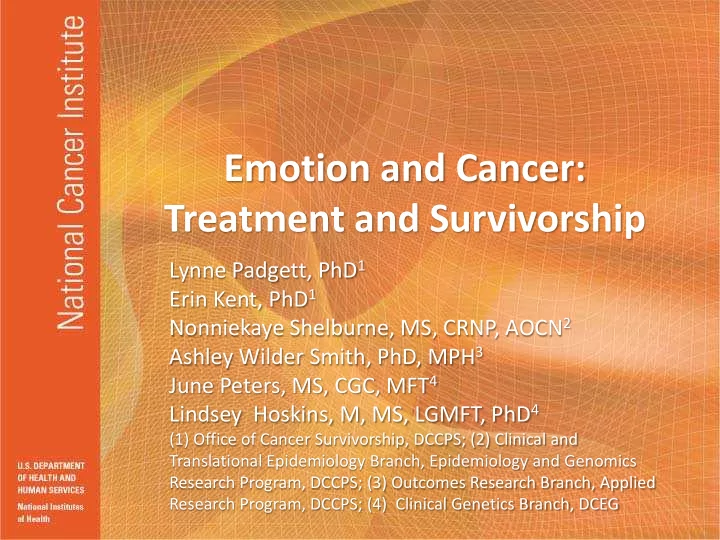

Emotion and Cancer: Treatment and Survivorship Lynne Padgett, PhD 1 Erin Kent, PhD 1 Nonniekaye Shelburne, MS, CRNP, AOCN 2 Ashley Wilder Smith, PhD, MPH 3 June Peters, MS, CGC, MFT 4 Lindsey Hoskins, M, MS, LGMFT, PhD 4 (1) Office of Cancer Survivorship, DCCPS; (2) Clinical and Translational Epidemiology Branch, Epidemiology and Genomics Research Program, DCCPS; (3) Outcomes Research Branch, Applied Research Program, DCCPS; (4) Clinical Genetics Branch, DCEG
Outline • Definitions and meaning of cancer survivor/ survivorship • The cancer control continuum • The survivorship tracks: (1) typical (2) poor-functioning • Lifecourse perspective • Caregiving context • Socio-cultural factors
Cancer Control Continuum “Revisited” End of life/ Risk Palliative care Survivorship assessment/ Prevention Screening Treatment and Detection Diagnosis Adapted from Rowland and Bellizzi, 2008, Hematol Oncol Clin North Am
Cancer treatment and survivorship • “Survivor”: – An individual from time of diagnosis onward through the balance of his or her life. – Friends, family members, and caregivers • Survivorship research: focus on the physical, emotional, social, and financial outcomes among pediatric and adult survivors and their friends, families, and caregivers. • Survivor identities (Park et al., 2009, J Gen Intern Med ): – “Patient,” “survivor,” “person with cancer,” and “victim”
Two tracks… 1. Typica l: many survivors, who have healthy levels of pre-cancer emotional functioning) 2. Poor-functioning: those who either have preexisiting psychological comorbidities or come from stressful contexts)
One Dominant Emotion: Distress • Distress definition: a multi-determined unpleasant emotional experience of a psychological, social and/or spiritual nature that may interfere with the ability to cope effectively with cancer, its symptoms and treatment. -National Comprehensive Cancer Network, 2002
Tracks Responses to Distress High Distress Typical Blunted Diagnosis Treatment End of No Recurrence Advanced End of Treatment Evidence or Cancer or Life of progression Treatment Disease Failure Time since diagnosis
Consider the Lifecourse • Emotional response may differ for survivors and caregivers, depending on the age/developmental stage of survivor – Children (age 0-14) – Adolescents, Young Adults (AYA) (age 15-39) – Middle aged adults (age 40-59) – Older Adults (age 60+) • Impact on family differs by age/life stage
Family Caregivers Risk Factors Physical Outcomes Emotional Outcomes • Caregiver age • Lack of sleep • Emotional distress • Caregiver gender • Unhealthy & irregular • Anxiety eating • Education level • Depression • Fatigue • Spirituality • Posttraumatic stress • Decreased physical symptoms • Disease status activity • Anger • Treatment intensity • Chronic disease • Loss of Role management • Relationship • Stress • Accelerated aging • Responsibilities • Guilt • Coping methods • Income concerns
Multiple levels of socio-cultural factors Policy ex. Survivorship care planning, standard s of care Community/Culture ex. work, school, neighborhood, heritage Healthcare Team Healthcare providers, patient navigators Family/Caregivers Survivor Adapted from Stokols, 1996, American Journal of Health Promotion
Socio-cultural perspectives on cancer survivorship • Cancer survivorship, in terms of emotional health, entails meaning-making – Differs across individuals and across socio-cultural scales • Survivorship interventions should be tested in any new population and then tailored to be relevant, sensitive, and meaningful for specific groups. • Big need for qualitative research to understand how experiences in treatment and survivorship unfold for different cultural groups and quantitative research to expand inclusion of understudied groups
End of Life and Palliative Care • Time of heightened emotion for survivors and their family • Decisions to accept or decline treatment • Elevated levels of emotion for – Decision to stop treatment – End of life care – Death
Summary • Definitions and meaning of cancer survivor/ survivorship • The cancer control continuum • The survivorship tracks: (1) typical (2) poor-functioning • Lifecourse perspective • Caregiving context • Socio-cultural factors
References 1.Alfano CM, Rowland JH (2006) Recovery issues in cancer survivorship: a new challenge for supportive care. Cancer J 12: 432- 443 2.Park CL, Zlateva I, Blank TO (2009) Self-identity after cancer: "survivor", "victim", "patient", and "person with cancer." J Gen Intern Med 24 Suppl 2: S430-435 3. Stokols D (1996) Translating social ecological theory into guidelines for community health promotion. Am J Health Promot 10: 282-298 4. Rowland JH, Bellizzi KM (2008) Cancer survivors and survivorship research: a reflection on today's successes and tomorrow's challenges. Hematol Oncol Clin North Am 22: 181-200, v 5. Stein KD, Syrjala KL, Andrykowski MA (2008) Physical and psychological long-term and late effects of cancer. Cancer 112: 2577-2592
Extra slides for handouts
Estimated Number Cancer Survivors in the US 1971 - 2006 Projections including and excluding in situ 2007-2020 20 18 16 Number in millions 14 12 10 8 6 4 2 Year 0 1971 1976 1981 1986 1991 1996 2001 2006 2011 2016 U.S. Estimated Prevalence counts (excluding in situ) Projections including in situ Projections excluding in situ Warren et al., Current and Future Utilization of Services From Medical Oncologists, JCO, 2008
Glass & McAtee, 2006, Social Science & Medicine
Recommend
More recommend